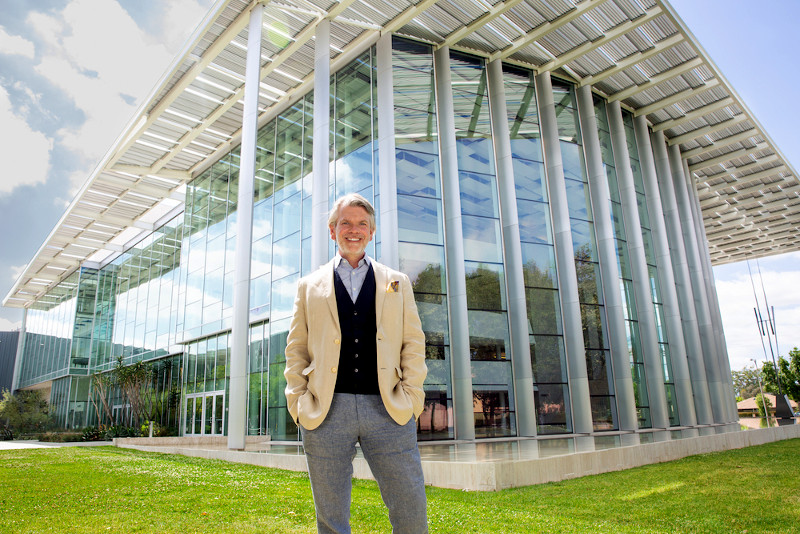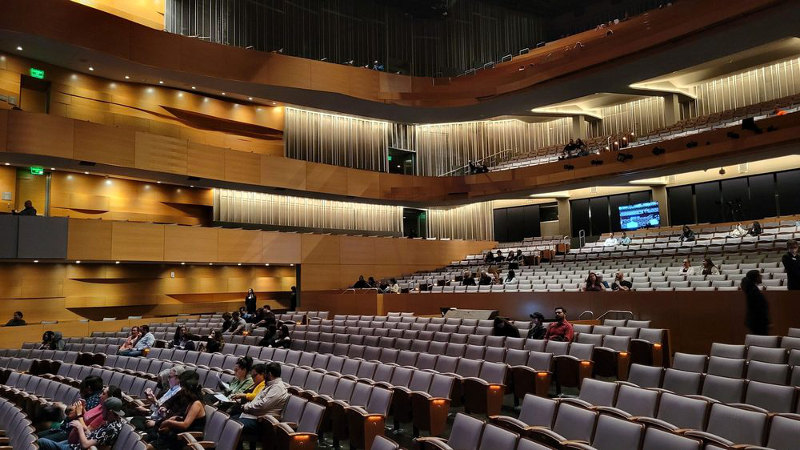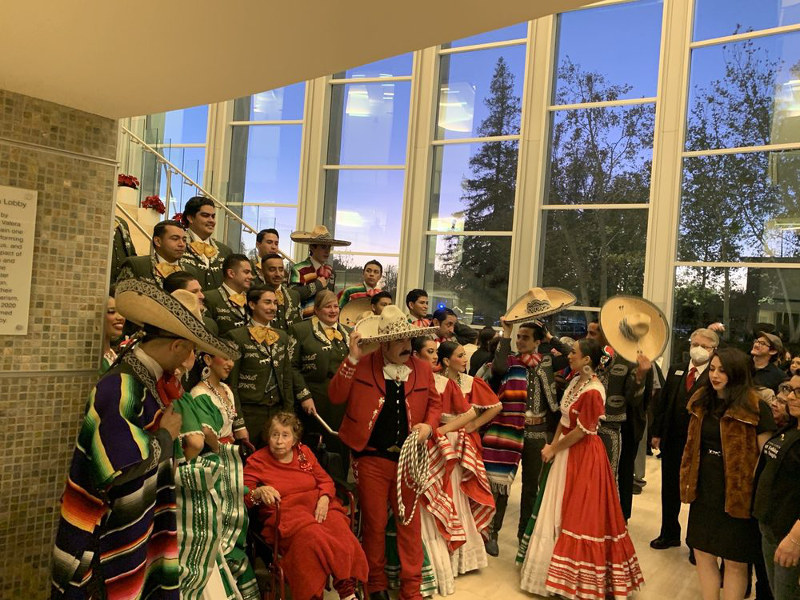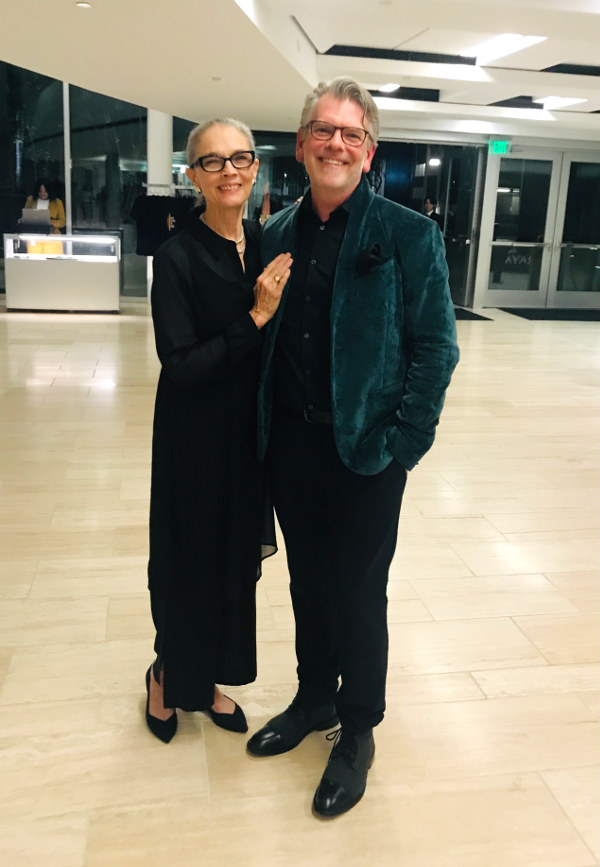
“Three wows” sold Thor Steingraber on The Soraya. Steingraber’s long interview process in the fall of 2013 and winter of 2014 to become top executive of Cal State Northridge’s newish theater culminated in a site visit. As he marks ten years as The Soraya’s executive and artistic director, he remembers this moment as his first “wow.” Driving toward the then-named Valley Performing Arts Center, Steingraber saw California sunlight refracting golden hues from the symmetrical structure’s glass walls. He was smitten.
Stepping into The Soraya lobby, he had his second “wow.” A high-ceilinged, airy space anchored in natural stone and tile, it evoked a church, on that day, equally as hushed. Under Steingraber’s aegis, a lively town square would evolve in the lobby, buzzing with community conversation before and after shows, and during intermissions.
The third “wow” proved the dealmaker—it came in the auditorium itself. A longtime man of the theater having worked at two of the nation’s largest performing arts centers, Steingraber had also, for twenty years, directed opera in many a marvelous theater around the world. But sitting in The Soraya brought an epiphany. “I went up to the best seat in the house, Loge level center,” Steingraber remembers. “It is a full-on view—the sweet spot for a photograph. And I’m thinking, this place is incredible.” His purview encompassed a gracefully sloping, 1,700-seat concert hall in four tiers, with long opera boxes gracing both sides. Wall panels of stainless-steel mesh interspersed with curving wooden ribbons draw the eye toward the stage.

“It’s not a flashy building,” says Steingraber downplaying the simple beauty. “It’s just a building that got it right.” He lost little time in launching a torrent of performances: those appealing to broadly diverse audiences; those syncing with CSUN’s wide-ranging educational mission; and Steingraber’s greatest pride, top-notch original Soraya productions like DIAVOLO’s recent Existencia—more “arts happenings” than “shows.”
Thus, the youthful, Chicago-born, Indiana University and Harvard-educated Steingraber—plugged-in, high-energy, exacting—took a job he seemed destined to fulfill. His mantle includes programming (with Justin Souza of his staff), as well as instilling the intricate web of management systems that makes a fine theater hum. That part of the job has been very demanding: “The building was only three years old,” he says, “and I had to create all the business functions from scratch—the parking, loading dock, security, concessions, backstage operations, front-of-house operations, ticket operations, hospitality, marketing, every aspect of it.” Only the strong would survive. “It was a daunting task,” he admits, “and that feeling has almost never left.”
Steingraber shepherded the venue’s name change in 2017 when philanthropists Younes and Soraya Nazarian and the Nazarian family, in recognition of the worthiness of programs and audiences served, endowed the future of the venue with a seventeen-million-dollar gift.

Of paramountcy, says Steingraber, “Artists love being here.” Confirming that assertion were five of the theater’s most well-liked, returning artists, members of The Soraya family, in conversation. Among them, the dynamic double-bassist John Clayton of the Clayton-Hamilton Jazz Orchestra, credits The Soraya’s emergence as an arts magnet to one man, whom he calls, tongue-in-cheek, “the great god Thor.”
“I do think he lives up to what his name represents, a superhero,” says Clayton. “Thor is a master at planting a seed and expecting me to water, nurture, and cultivate it. I’m so glad he likes the Clayton-Hamilton big band. But what I like more is him saying, ‘Can we think of something special in addition to just presenting the band, it might be a theme, it might be a guest.’ Thor has asked, ‘Have you heard of Samara Joy? Have you heard of Conrad Tao?’ That is always so interesting, versus someone just saying, ‘We’re interested in having you. What do you cost?’”
Cheche Alara, a regular conductor of the Latin Grammy Awards, also a composer/arranger, has led several Latin-themed Soraya concerts, including tributes to Dolores Huerta and Linda Ronstadt. Treating artists with dignity and respect, asserts Alara, is a “culture” at The Soraya. Alara likes the way ushers warmly and enthusiastically greet concertgoers at the doors. This is not random; those friendly greeters are well-trained CSUN students, yet another way the theater integrates positively with the university.
Alara notes that, “The Soraya people are not just doing their job, but sharing your passion, the moment you step foot there, you feel seen as an artist.” Backstage, says Alara, the atmosphere is so upbeat that, “every time I go on that stage, I’m in as festive a mood as I can be.”

Janet Eilber, whose long stewardship of Martha Graham Dance Company is predicated on renewing the relevance of the company’s classic choreography of the last century, feels simpatico with Steingraber’s mode of creativity. “We are so aligned with how to find as many creative connections to the audience as possible,” Eilber says. “Not just because of the relationship with Graham, but the fact that he does the backstage Jazz Club; the fact that he does a Mariachi Christmas show. That is so deeply thoughtful of him and of the audience he seeks to connect with.”
Eilber, who sweated out a pre-performance week with ten of her dancers infected with COVID, remembers Steingraber’s team’s daily arrival at the company’s hotel, loaded down with COVID tests. Miraculously, each dancer tested negative before the show. “He’s always even keeled,” said Eilber. “With a sense of humor about all the crazy stuff that happens, Thor continues to move things forward.”
The Soraya’s canvas for creativity is so inviting, it tickles the potential for artistic expansion. “He has been so extraordinarily collaborative and creative for all of our performances. He is one of the most generous and creative presenters,” says Eilber in a cross-country call. “It’s the perfect atmosphere that he creates, so creative artists feel safe, they don’t feel judged or restricted, you feel his support.”
Steingraber is open to a pitch. When Noreen Green, conductor and director of the Los Angeles Jewish Symphony (also a CSUN graduate and former instructor), cold-called him to pitch the Violins of Hope project, she was struck by his immediate response. Steingraber saw in the Violins the righteous, heart-stopping physical mementos of the Holocaust that they are.
“He came to our first meeting and took the ship by the helm to steer the Violins project in L.A., where there are a lot of personalities in the Jewish community,” said Green, by telephone. “Then the pandemic hit, two days before our first rehearsal.”
The violins had already arrived at The Soraya, says Green. Steingraber, “under enormous pressure, world circumstances, took the helm and created a safe space for them to remain. The thing is, he is so gracious under pressure; he remains calm and cool.”
“The big thing Thor has done,” says Christopher Rountree, conductor/creative director of the Los Angeles-based contemporary-classical music ensemble wild Up, “he was one of the first people in town to believe in us, and to say, ‘This has value.’ He was one of the first people to say, ‘We need L.A. to be important, and we are going to look for talent here, and give it a platform.’ There is a bias in this town about local artists. Thor doesn’t have that.”
Rountree and wild Up have also benefited enormously from Steingraber’s method of pairing artists for shared programs, sparking creative synergies. “He does a lot of matchmaking,” says Rountree, whose pairing with the Graham Company has endured.
Steingraber also plays matchmaker by pairing CSUN’s student performers with the visiting pros. Artists like Wynton Marsalis and the Graham dancers trust the care with which Steingraber makes such pairings; for the selected CSUN students, it is a life-changing experience.
When the gut punch of March 2020 arrived, Steingraber seemed to tap his reserve of Scandinavian cool in the face of a raging pandemic. Like every arts presenter in the world, he brought his performance calendar to a screeching halt. But from that lemon evolved an unintended consequence—“live streaming.” If implemented smartly, believes Steingraber, this capability of our modern era will benefit The Soraya, and he intends to weave it into future programming. “What’s interesting is we generally double our audience,” he says, “however many people are with us watching the show live, there’s a whole other equal audience watching it at home.”
But it wasn’t until January 2022, as a flight filled with the London-based Royal Philharmonic Orchestra was bearing down on LAX and the Omicron variant making the rounds, that Steingraber took up this option. Fed up with cancelling shows, he live-streamed the concert to ticketholders. The thirteen-camera crew’s learning curve was steep. Faced with the launch of the Jazz at Naz Festival following shortly, he asked the crew to “stick around for two more weeks.” Pondering the optimal format in which to deliver the program, he had “this crazy idea.”
He would do it “just like ESPN.” So Steingraber, an avid baseball fan, adopted the sports-broadcasting paradigm, with two co-hosts conducting “commentary before the concert, commentary at ‘halftime’; and a post-performance wrap up.” As he recalls, “In the first year, [wunderkind jazz singer] Samara Joy wins her double Grammy and does her concert. We interview her at intermission, she slides into her seat and delivers a substantive interview to Soraya patrons at home.” Those who attend programs in person have the option to re-watch the video at home to re-experience it, or to hear its commentary and interviews, or to share with family members. (The content, with commentaries baked-in, is accessible for forty-eight hours after the performance.)
It took three wows for Thor Steingraber to fall for The Soraya. After a decade in the job, he’s observed many first-time patrons have the same experience. “We intend to exceed expectations, especially for those who travel a distance,” he says. “There is skepticism in Los Angeles about getting a payoff for driving. Even if our venue is in the far reaches of the Valley, if you make the effort, we know we can deliver three wows. And we’ll top it with a fourth—a world-class performance.”
“I took this job for a specific reason,” continues Steingraber. “I was allured by the idea of a new venue and the challenge that held—especially when the venue itself was so excellent. In other words, how do you live up to this place? Well, you must fill it. Of course with an audience. But you also must fill it with spirit, art, and intentionality. I had no idea how long that would take. And I had no idea how strangely committed I would be in fulfilling that task.” Unsurprising to all who have observed Steingraber in this very public-facing position is his admission, “The job is hard. It’s not even a job. It’s a lifestyle. It’s 24/7. It consumes you. How could it not?”
Los Angeles arts journalist Debra Levine, who founded artsmeme in 2008, enjoys writing essays for The Soraya.

Thor has made the Soraya one of the best programmed theatres in the performing arts in Los Angeles. I have never been disappointed when I come see one of his commissioned projects or presentations. He has assembled a terrific staff.
Margaret Selby